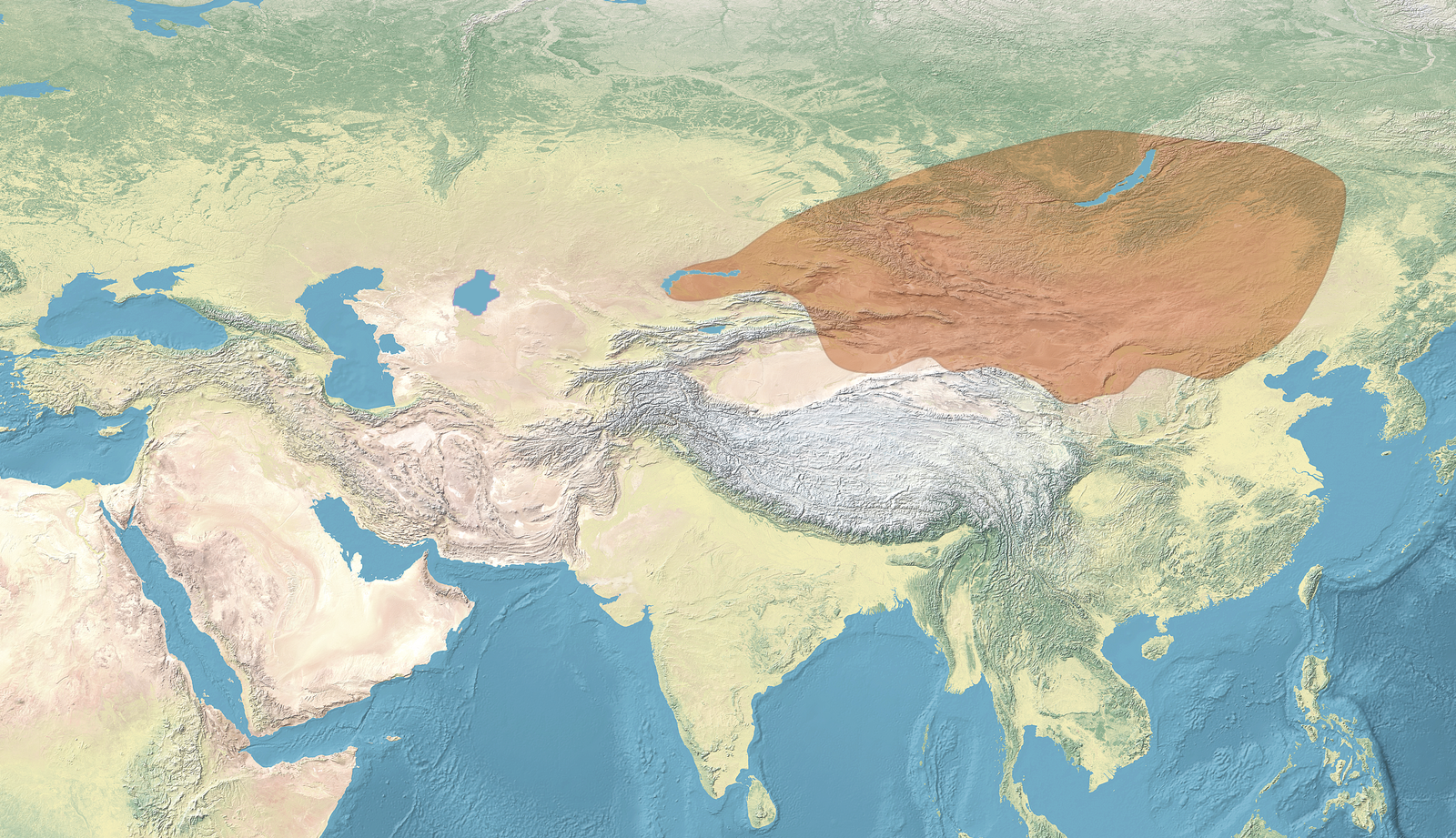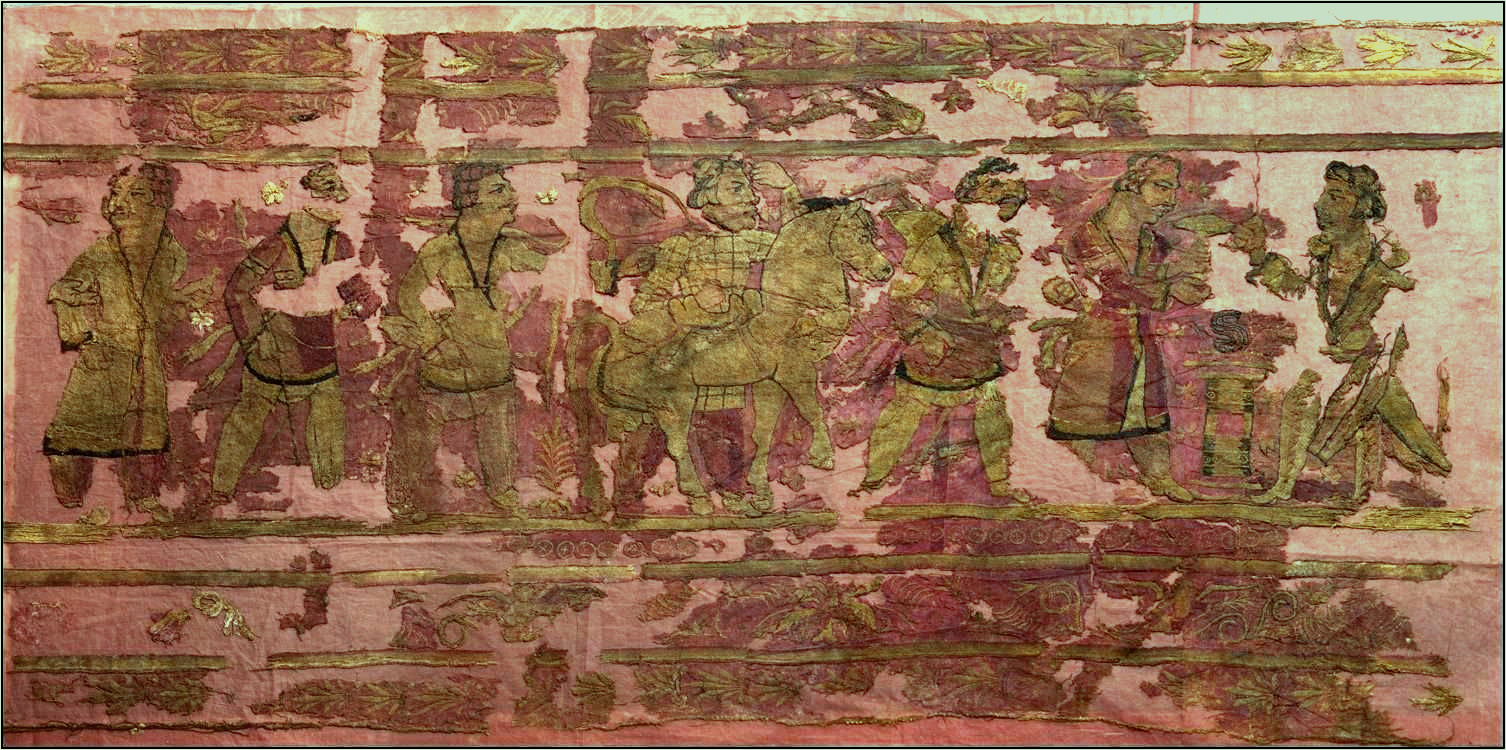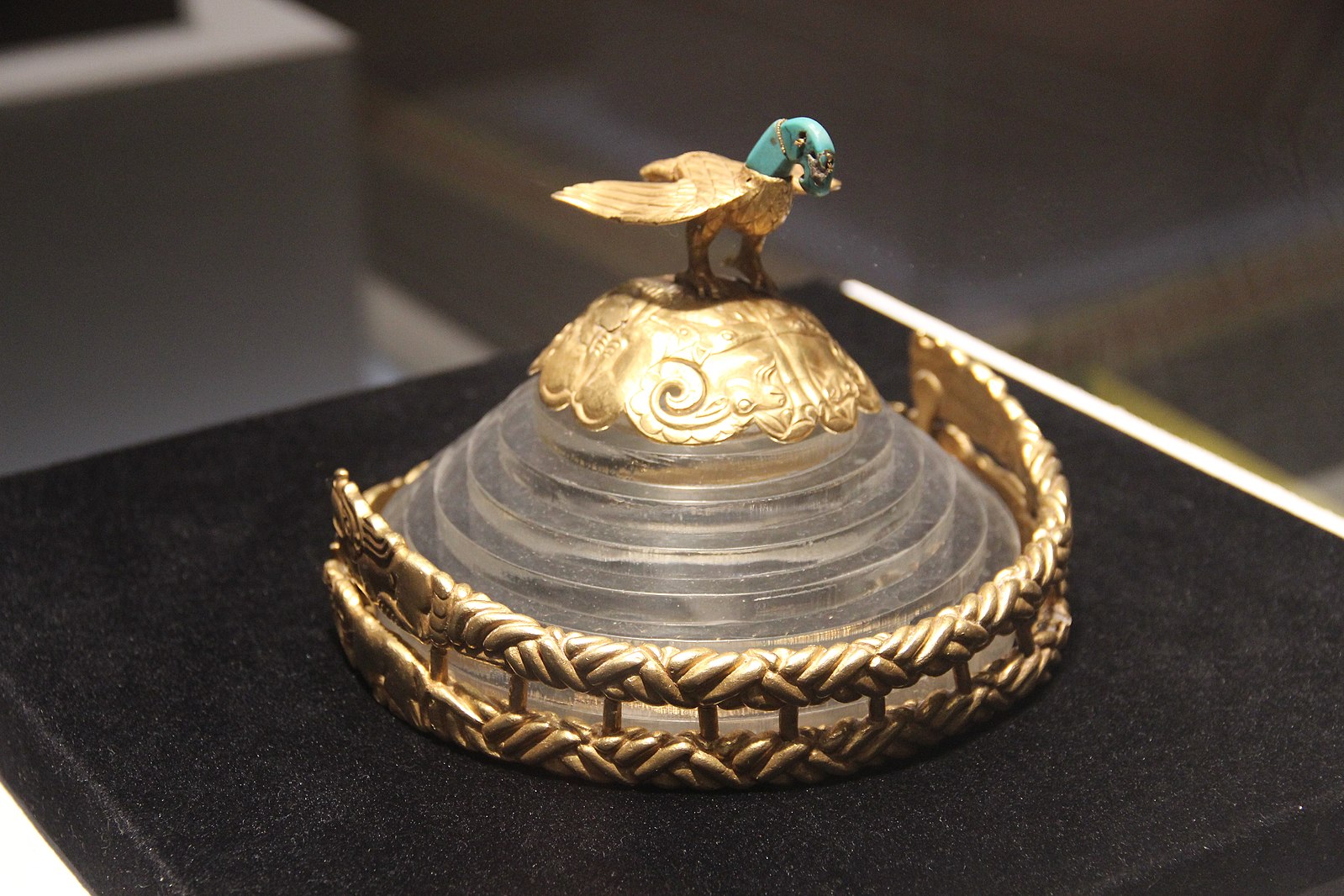5.6: Xiongnu – 3rd century BCE – 1st century CE
- Page ID
- 232282
\( \newcommand{\vecs}[1]{\overset { \scriptstyle \rightharpoonup} {\mathbf{#1}} } \)
\( \newcommand{\vecd}[1]{\overset{-\!-\!\rightharpoonup}{\vphantom{a}\smash {#1}}} \)
\( \newcommand{\id}{\mathrm{id}}\) \( \newcommand{\Span}{\mathrm{span}}\)
( \newcommand{\kernel}{\mathrm{null}\,}\) \( \newcommand{\range}{\mathrm{range}\,}\)
\( \newcommand{\RealPart}{\mathrm{Re}}\) \( \newcommand{\ImaginaryPart}{\mathrm{Im}}\)
\( \newcommand{\Argument}{\mathrm{Arg}}\) \( \newcommand{\norm}[1]{\| #1 \|}\)
\( \newcommand{\inner}[2]{\langle #1, #2 \rangle}\)
\( \newcommand{\Span}{\mathrm{span}}\)
\( \newcommand{\id}{\mathrm{id}}\)
\( \newcommand{\Span}{\mathrm{span}}\)
\( \newcommand{\kernel}{\mathrm{null}\,}\)
\( \newcommand{\range}{\mathrm{range}\,}\)
\( \newcommand{\RealPart}{\mathrm{Re}}\)
\( \newcommand{\ImaginaryPart}{\mathrm{Im}}\)
\( \newcommand{\Argument}{\mathrm{Arg}}\)
\( \newcommand{\norm}[1]{\| #1 \|}\)
\( \newcommand{\inner}[2]{\langle #1, #2 \rangle}\)
\( \newcommand{\Span}{\mathrm{span}}\) \( \newcommand{\AA}{\unicode[.8,0]{x212B}}\)
\( \newcommand{\vectorA}[1]{\vec{#1}} % arrow\)
\( \newcommand{\vectorAt}[1]{\vec{\text{#1}}} % arrow\)
\( \newcommand{\vectorB}[1]{\overset { \scriptstyle \rightharpoonup} {\mathbf{#1}} } \)
\( \newcommand{\vectorC}[1]{\textbf{#1}} \)
\( \newcommand{\vectorD}[1]{\overrightarrow{#1}} \)
\( \newcommand{\vectorDt}[1]{\overrightarrow{\text{#1}}} \)
\( \newcommand{\vectE}[1]{\overset{-\!-\!\rightharpoonup}{\vphantom{a}\smash{\mathbf {#1}}}} \)
\( \newcommand{\vecs}[1]{\overset { \scriptstyle \rightharpoonup} {\mathbf{#1}} } \)
\( \newcommand{\vecd}[1]{\overset{-\!-\!\rightharpoonup}{\vphantom{a}\smash {#1}}} \)
\(\newcommand{\avec}{\mathbf a}\) \(\newcommand{\bvec}{\mathbf b}\) \(\newcommand{\cvec}{\mathbf c}\) \(\newcommand{\dvec}{\mathbf d}\) \(\newcommand{\dtil}{\widetilde{\mathbf d}}\) \(\newcommand{\evec}{\mathbf e}\) \(\newcommand{\fvec}{\mathbf f}\) \(\newcommand{\nvec}{\mathbf n}\) \(\newcommand{\pvec}{\mathbf p}\) \(\newcommand{\qvec}{\mathbf q}\) \(\newcommand{\svec}{\mathbf s}\) \(\newcommand{\tvec}{\mathbf t}\) \(\newcommand{\uvec}{\mathbf u}\) \(\newcommand{\vvec}{\mathbf v}\) \(\newcommand{\wvec}{\mathbf w}\) \(\newcommand{\xvec}{\mathbf x}\) \(\newcommand{\yvec}{\mathbf y}\) \(\newcommand{\zvec}{\mathbf z}\) \(\newcommand{\rvec}{\mathbf r}\) \(\newcommand{\mvec}{\mathbf m}\) \(\newcommand{\zerovec}{\mathbf 0}\) \(\newcommand{\onevec}{\mathbf 1}\) \(\newcommand{\real}{\mathbb R}\) \(\newcommand{\twovec}[2]{\left[\begin{array}{r}#1 \\ #2 \end{array}\right]}\) \(\newcommand{\ctwovec}[2]{\left[\begin{array}{c}#1 \\ #2 \end{array}\right]}\) \(\newcommand{\threevec}[3]{\left[\begin{array}{r}#1 \\ #2 \\ #3 \end{array}\right]}\) \(\newcommand{\cthreevec}[3]{\left[\begin{array}{c}#1 \\ #2 \\ #3 \end{array}\right]}\) \(\newcommand{\fourvec}[4]{\left[\begin{array}{r}#1 \\ #2 \\ #3 \\ #4 \end{array}\right]}\) \(\newcommand{\cfourvec}[4]{\left[\begin{array}{c}#1 \\ #2 \\ #3 \\ #4 \end{array}\right]}\) \(\newcommand{\fivevec}[5]{\left[\begin{array}{r}#1 \\ #2 \\ #3 \\ #4 \\ #5 \\ \end{array}\right]}\) \(\newcommand{\cfivevec}[5]{\left[\begin{array}{c}#1 \\ #2 \\ #3 \\ #4 \\ #5 \\ \end{array}\right]}\) \(\newcommand{\mattwo}[4]{\left[\begin{array}{rr}#1 \amp #2 \\ #3 \amp #4 \\ \end{array}\right]}\) \(\newcommand{\laspan}[1]{\text{Span}\{#1\}}\) \(\newcommand{\bcal}{\cal B}\) \(\newcommand{\ccal}{\cal C}\) \(\newcommand{\scal}{\cal S}\) \(\newcommand{\wcal}{\cal W}\) \(\newcommand{\ecal}{\cal E}\) \(\newcommand{\coords}[2]{\left\{#1\right\}_{#2}}\) \(\newcommand{\gray}[1]{\color{gray}{#1}}\) \(\newcommand{\lgray}[1]{\color{lightgray}{#1}}\) \(\newcommand{\rank}{\operatorname{rank}}\) \(\newcommand{\row}{\text{Row}}\) \(\newcommand{\col}{\text{Col}}\) \(\renewcommand{\row}{\text{Row}}\) \(\newcommand{\nul}{\text{Nul}}\) \(\newcommand{\var}{\text{Var}}\) \(\newcommand{\corr}{\text{corr}}\) \(\newcommand{\len}[1]{\left|#1\right|}\) \(\newcommand{\bbar}{\overline{\bvec}}\) \(\newcommand{\bhat}{\widehat{\bvec}}\) \(\newcommand{\bperp}{\bvec^\perp}\) \(\newcommand{\xhat}{\widehat{\xvec}}\) \(\newcommand{\vhat}{\widehat{\vvec}}\) \(\newcommand{\uhat}{\widehat{\uvec}}\) \(\newcommand{\what}{\widehat{\wvec}}\) \(\newcommand{\Sighat}{\widehat{\Sigma}}\) \(\newcommand{\lt}{<}\) \(\newcommand{\gt}{>}\) \(\newcommand{\amp}{&}\) \(\definecolor{fillinmathshade}{gray}{0.9}\)Introduction
The Xiongnu Empire was mainly located in present-day Mongolia and stretched from Northern China, southern Siberia, and Central Asia for three centuries.[1] The nomadic people populated the Eurasian Steppe region shown on the map (5.6.1) in red. The Xiongnu were pastoral, nomadic people who maintained large herds of horses, cows, and sheep. They did not establish any agriculture, relying on a diet based on herd animals. The Xiongnu did not construct large cities or permanent walled structures. The men were exceptional warriors, riding on horseback and fighting with bow and arrows while in motion. Modu Chanyu was the son of Touman who founded the empire and Modu was a military leader under his father. Modu ordered his men to kill his father and he took the throne as the supreme leader of the empire. Modu used his military capabilities to start attacking the Chinese and growing the empire.

Centered on the Mongolian Plateau, the Xiongnu were the dominant people who had a complex relationship with the Chinese dynasties. The Xiongnu made frequent military battles against some of northern Chinese territories taking people as slaves and using the grain and fruit crops to feed their herds of animals. The Chinese Han rulers had great disdain for the Xiongnu but realized the military prowess and threat. The Han was forced to give annual tributes of rice, silk, and wine. By 104 BCE, the Han successfully recovered most of their northern regions and constructed forts and outposts to maintain their power and weaken the Xiongnu. By 91 CE, the Xiongnu were significantly driven out of the region and their leadership dissipated.
The time of the Xiongnu power generally dates to the period the Silk Road started. They carried Roman glass, Persian textiles, Egyptian faience, Greek silver, and Chinese bronzes, silks, and lacquerware across the empire.[2] Many of the objects found in Xiongnu tombs appear to be imported from other places indicating the active participation of the Xiongnu in the trade roads passing through their territory. Different objects excavated from Xiongnu tombs displayed ‘western’ features while other objects connected to China.
Carpet
An unusual number of carpets were found during the excavation of cemeteries in Noyon-ula. Multiple silk, wool, and felt carpets were discovered throughout the different cemeteries. The embroidered carpets were an extreme luxury possession and were portable leading to their popularity in a nomadic culture. The carpets were produced with the same methods; the embroidery was created in long widths from sheep, camel, or other wool and sewn together. A strip was sewn onto the top and bottom of the carpet and usually embroidered. Woven golden thread was generally attached with another thin yarn, probably made from silk. The changing direction of the threads gave similar appearances as brushstrokes of oil paint. Wool was usually dyed with shades of red.
“To produce such colors, several dyes, in the first place, laccain acid (“Indian lacquer”), were used. It is secreted by carteria lacca, insects originating from East India and bordering countries.”[3]
Archaeologists have found different cultural evidence demonstrating differences between Xiongnu and Chinese art. Examples like the Noin-Ula carpet (5.6.2) show some similar aspects of Chinese art. The Xiongnu have long braided hair with ribbons, a style seen in the Han dynasty pictures. However, clothing worn by the men in the carpet appear to have the same type of decorations and silhouette as an Iranian style. On the far-right side of the carpet, something was presented to a Zoroastrian priest who is standing by a fire alter. The Xiongnu used a Scythian style for the animals. The horse is the focal point of the Noyon uul carpet (5.6.3) and a stylized horse had an elaborate braided hairstyle and its legs moved asynchronously. The stylized, artistic version of the horse was considered significantly more beautiful than western designs of horses. Using modern analysis techniques, researchers concluded this carpet was made from camel wool. The macrophotography also confirmed the fact of “coloring had been applied to already manufactured cloth, not its yarn.”[4] The methodology used to color the carpet has not been defined.

Figure \(\PageIndex{2}\): Noin-Ula carpet (1st century BCE – 1st century CE) (Public Domain)

Between 2006 and 2015, the Institute of Archeology at the Mongolian Academy of Sciences and the Institute of Archeology and Ethnography of the Siberian Branch of the Russian Academy of Sciences jointly carried out archeological excavations and research at the location, discovering some 1,200 artifacts from 8 Xiongnu tombs in total. As a result of the research, textile items that had yet to be discovered intact were discovered alongside rare artifacts such as silver accessories and gear with mythical creatures.
Gold
Large numbers of golden belt buckles were found in Xiongnu burial sites. The belt buckles were portable and a way to demonstrate wealth. The buckles illustrate stylized animals as they are twisted and frequently in combat with other animals. Many of the buckles had inlays of stone or glass inlaid. The buckles were cast of molten precious metals. Both of the belt buckles (5.6.4, 5.6.5) have holes on the left side where a cord was inserted and tied as part of the fastening system. Both buckles have mythological zoomorphic scenes as stylized animals appear in combat. The buckles were cast in the lost-wax method and any fine details incised later or inlaid with precious metals. Attachment loops were attached to the reverse side as part of the casting process. The third belt buckle (5.6.6) is quite different from the flatter, simpler buckles. The three-dimensional buckle depicts a horseman spearing an animal. The rider is dressed in typical garb for the nomadic Xiongnu and the horse is covered with typical elements of the nomadic people. This buckle is far more elaborate and dimensional and originally owned by someone with greater wealth.


.jpg?revision=1&size=bestfit&width=773&height=814)
The gold crown (5.6.7) is believed to be the only king’s crown of the Xiongnu currently found. The crown is comprised of two parts; the top part is round with a wavy edge and the other part are the braided golden bands. The top section would fit like a skull cap and is incised with four sets of wolves who are biting sheep. On the very top is a golden eagle with a turquoise head. Stylized sheep and horses, along with a crouching tiger ready to pounce are carved into the headband’s ends. Gold threads connected the eagles head, neck, and tail and the parts moved as the rider speed across the plains. Scientists researched the gold used in different Xiongnu burial items to understand if they were made from gold mined in Mongolia or imported from China. Current research suggested the gold was obtained by the Xiongnu themselves and not imported. They did pan for gold in streams instead of mining.

Iron
Bronze or iron cauldrons were important for the Xiongnu. The cauldrons were used for cooking or rituals. The features on the cauldron, especially the handles identified the use of the cauldron and the area the cauldron was made. The cauldrons were made with a pedestal, body, and handles. Each part was created separately and then joined before casting. The size of the handles was important to identify the uses of each cauldron. Handles were frequently found as they broke off or were saved and buried for other uses. Small handles came from smaller metal cauldrons used for cooking. Different cauldrons might be used to hold fermented milk, cook meat, or even the pot for a narcotic drink. Markings or hieroglyphs on the cauldron might have identified its use. The iron cauldron (5.6.8) was made with unusual rectangular handles. Even the handles are decorative. The sides have lines and other details defining the specific cauldron.
.jpg?revision=1&size=bestfit&width=647&height=863)
[1] Genetic population structure of the Xiongnu Empire at imperial and local scales
[2] Ibid.
[3] History Embroidered in Wool
[4] An experiment in studying the felt carpet from noyon UUl by the Method of polyploidization

